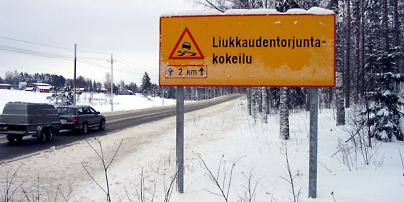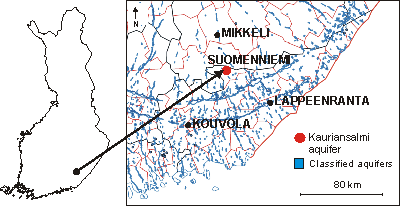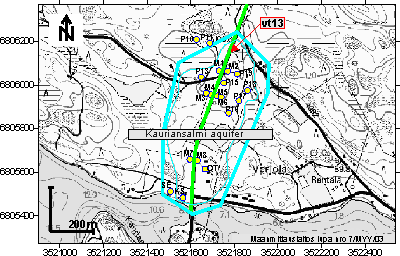Shortcut: http://syke.fi/projects/midas

Background
Approximately 70 % of Finnish people depend on groundwater for their water supply. In Finland there are more than 2000 aquifers that are classified as important for water supply. Twenty-four percent (528) of these aquifers are located underneath roads that are being deiced in winter. Traditionally, chloride salts have been used in winter road deicing. These chemicals, however, have spoilt groundwaters in Finland and elsewhere (Nysten and Suokko 1998). The major harmful effects of the chloride salts applied in deicing are dissolution of heavy metals from the soil matrix, chemical residues, and depletion of oxygen in groundwater due to application of organic deicing agents. The latter often results in increase in the concentration dissolved iron in groundwater. In Finland, groundwaters are typically characterized by softness, low pH, and low alkalinity. Resulting from this, increase of groundwater chloride increases the corrosiveness of groundwater to water pipes.
According to environmental legislation in Finland, spoiling of groundwater is strictly forbidden. On the other hand, winter road deicing cannot be completely stopped because traffic safety must be maintained. Therefore, novel solutions have to be found to minimize the deleterious effects of winter road deicing on groundwater resources without jeopardizing traffic safety.
Instead of sodium chloride that is traditionally used for winter road deicing, other chloride salts (e.g. calcium or magnesium chloride), or organic salts such as potassium formate, potassium acetate or calcium-magnesium acetate, can be used to deice roads. However, no or limited data were available on the effects of such deicing chemicals on groundwater or the environment. Comparisons between impacts of traditional and alternative deicing chemicals on groundwater had not been performed.
Studies on alternative deicing agents and their impacts on groundwater first begun at SYKE in 1998 as MIDAS project (Migration of alternative de-icing chemicals in aquifers) was launched. After 6 years of research in MIDAS project, fate and biodegradation of potassium formate in soil and groundwater upon its long-term application in road deicing were investigated in a follow-up project MIDAS2 (2004-2010).
Studies on laboratory scale and in sand columns (1998-2001)
The goal of MIDAS and MIDAS2 projects was to find a chemical that is suitable for deicing and that has impacts on groundwater as little as possible. In the first phase, the behavior and potential effects on groundwater of six different deicing chemicals (NaCl, CaCl2, MgCl2, calcium-magnesium acetate, potassium formate, and potassium acetate) in pilot scale sand columns (Figure 1) were investigated (Hellstén and Nystén 2003). The outcome of the study was that potassium formate is the most promising candidate for groundwater friendly deicing:
- Potassium formate contains no chloride
- Potassium formate caused the least dissolution of trace metals into the water that infiltrated through the sand column
- Formate degraded to carbon dioxide in the 4 m tall sand columns at 3-6 oC temperature. degradation accelerated after three weeks from the initiation of the experiment
- Oxygen consumption in the potassium formate-fed soil column was significantly lower than that of potassium acetate
It also appeared that degradation of the organic deicing chemicals was significantly faster in the sand columns with than without organic horizon

Figure 1. Laboratory scale experiments.
The studies were conducted with a lysimeter experiment at Oripää lysimeter station that aimed at simulating seasonal environmental conditions in Finland. In the study, lysimeters constructed in 1972, 1.7 m in thickness, filled with sandy soil from the Oripää esker, and covered with vegetation similar to that natural vegetation at the esker, were used. Potassium formate solution was poured onto the lysimeter and the chemical quality of the water percolated through the soil in the lysimeter was monitored. It appeared that formate was degraded in the lysimeter as well (Hellstén 2005b). However, the application of high dosage of potassium formate had a deleterious effect on the vegetation that grew on the lysimeter.
Beyond the studies summarized above, a number of related studies concerning the application of various de-icing agents were performed within the MIDAS project. The foci and the results of these investigations were following:
The toxicity of various deicing agents (NaCl, MgCl2, potassium formate, potassium acetate, and calcium-magnesium acetate) on plants were tested by using ecotoxicological laboratory methods (Joutti et al. 2003). The organic deicers appeared to be more toxic on plants than the chloride salts (Joutti et al. 2003). However, the rapid biodegradation of formate in soil reduces significantly the toxicity of the organic salts on plants (Hellstén and Nystén 2003).
The taste and odor in drinking water caused by various deicing agents were examined by using methods based on sensory impressions (Kivelä et al. 2003). The taste thresholds of potassium formate and other organic deicing salts were notably higher than that of sodium chloride (Kivelä et al. 2003).
Full scale studies (2002-2010)
The investigation on actual road and environmental conditions aimed at finding out the suitability of potassium formate for road deicing, and the impacts on groundwater quality of the chemical.
The application of potassium formate was started in October 2002 on a 1.7-km long stretch of Highway 13 at Kauriansalmi aquifer in the former municipality of Suomenniemi (nowadays Mikkeli) in South-Eastern Finland (Figures 2 and 3). Prior to this, from the late 1970´s, sodium chloride had been used as the deicing chemical on this stretch of the highway.
Since 2004, potassium formate is used as a sole deicing chemical and to replace sodium chloride at Taavetti aquifer at Luumäki (Hwys 6 and 26), at Jaamankangas aquifer at Kontiolahti (Hwy 6), and at Lintharju aquifer at Suonenjoki (Hwy 9). Later on, application of potassium formate has started i.a. at Honkalampi, Haminamäki-Humppi, Kärängänmäki, and Pajujärvi aquifers at Lapinlahti (Hwy 5). Next to above stretches of highways, formate and acetate based deicers are used on 25 airport in Finland.
The studies in MIDAS2 project have had their focus at Kauriansalmi aquifer where fate and biodegradation of formate have been investigated in soil, groundwater and surface water. Groundwater quality at the aquifer, including chloride concentrations, has been monitored in 2002-2013 in 20 groundwater wells installed in the area. In addition, Centres of traffic, and the environment have gained experience on the application and feasibility of potassium formate for deicing at the test areas. The central findings of the studies were:
- Potassium formate was used as the sole deicing agent at Kauriansalmi aquifer in 2002-2009. No formate was found in the groundwater during that period (Hellstén et al. 2004, Salminen et al. 2010).
- Formate rapidly biodegrades to carbon dioxide and water in the environment. In the ground, rapid biodegradation even at low temperatures (-2 oC… +1 oC) prevents formate from infiltrating into the groundwater. Biodegradation of formate proceed fast in surface water, as well. Therefore, the application of potassium formate in winter maintenance causes low load of organic carbon into surface water bodies (Hellstén et al. 2004, Salminen et al. 2010).
- Topsoil rich in organic matter and with high microbial activity is essential for the biodegradation of formate. In the case of sandy sediments with organic layer (either natural organic horizon or constructed grassland) on the top, unsaturated zone of 1-2 m in thickness is enough for sufficient formate biodegradation. If organic layer doesn't exist and the soil at the recipient (typically at roadsides) is gravely, unsaturated zone of 4 m or more is needed. (Hellstén ym. 2004, Salminen ym. 2010)
Key conclusions and applicability of the results
- Potassium formate is feasible for winter road deicing at roads and runways. In comparison with sodium chloride, potassium formate is more efficient against black ice and causes less salt spray in the traffic. For the removal of packed snow from the surface of asphalt pavement on roads, potassium formate is less effective than sodium chloride.
- The application of potassium formate for deicing is recommended in particular on roads that run along aquifers classified as important for water supply, and that have high risk for salinization from deicing. Potassium formate application is further recommended at airport when minimization of the impacts from deicing on groundwater and surface water bodies is desired.
- The application of potassium formate helps significantly to reduce the adverse impacts of winter maintenance on groundwater. In the near future, development of solutions and know-how on the practices that allow scarce and cost-efficient use of potassium formate in deicing are encouraged. Sodium chloride can still be used next to potassium chloride at sensitive groundwater areas for instance for the removal of packed snow.
- The total costs of road winter maintenance would increase by 5 to 10% if potassium formate was applied instead of the traditional road salt on all of those roads located at groundwater aquifers classified important for water supply. The total length of such roads is roughly 800 km in Finland.
The findings made in MIDAS and MIDAS2 projects can be used upon the selection of deicing agents among the existing selection of products. Furthermore, the results may prove valuable for the future development of environmentally sound deicing chemicals. The data obtained is applicable in climatic and geological conditions comparable to those in Finland (e.g. other Nordic countries and North America).

Figure 2. The Kauriansalmi aquifer in the former municipality of Suomenniemi (nowadays Mikkeli) in south-eastern Finland.

Figure 3. Location of the highway vt13 and monitoring wells around the Kauriansalmi aquifer.
More information
Project leader
Leading Expert Taina Nystén (PhD in hydrogeology), Finnish Environment Institute (SYKE), firstname.surname@syke.fi
Leading research scientist
Head of Unit Jani Salminen (PhD), Finnish Environment Institute (SYKE), firstname.surname@syke.fi